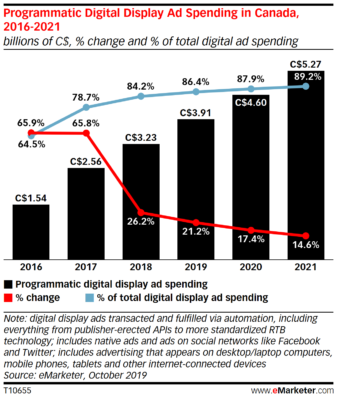The Future of Programmatic Advertising
As the digital landscape continues to evolve, marketers are finding more and more ways to reach out to customers with more personalized messaging. With digital advertising capabilities evolving and becoming more accessible, both marketers and consumers are changing their approach in order to develop more advanced advertising solutions. Programmatic advertising is one of the most widely used tools for providing that experience to customers.
In this post, we will explore what programmatic advertising is and what trends could possibly impact your marketing strategy in 2020.

What is Programmatic Advertising?
In its simplest form, programmatic advertising is the automated transaction of buying and selling advertising online. It’s the process of using different platforms to sell inventory on publishing sites and on the advertising side.
For a crash course in programmatic, check out this great article from MarketingWeek.com.

Programmatic advertising has grown significantly in recent years, with most digital marketing spends being spent on programmatic technology. Programmatic platforms have been growing their inventory and databases such that any format and any channel can be accessed programmatically today, including mobile, desktop, tablet, audio, digital outdoor and connected TV. This will continue to grow. With new third-party platforms (such as MIQ, Pelmorex, and NativeTouch), advertisers have found effective ways to reach out to their consumers in a more personalized way. As per eMarketer, by 2021, Canadian digital display advertisers will invest nearly $5.2-billion in programmatic buying which is approximately 89.2% of the total digital display ad spend.
Wondering if programmatic could be a fit for you? Check out our previous blog post “Choosing Between Search Engine Marketing or Programmatic Display Advertising.” If you’re already on board, read on!
2020 Trends
The most widely talked-about trends for Programmatic advertising in 2020:
1. Voice Activated / Audio Based Advertising
The adoption of smart speakers by consumers has been on a steady incline since they were introduced. As per Statista, the industry is rapidly expanding, with market revenue projections of over $27-billion in 2022 in the US. The two most popular brands in the smart speaker market are Amazon’s Echo/Alexa and Google Home/Google Assistant. According to the Smart Audio report 2019, more than 21% of the population owns at least one smart speaker.
While smart speakers are primarily being used to play music, they are also being used for a lot of other activities as well, such as making purchases – with most of those purchases being high value. The rapid increase in the adoption of these devices has created new opportunities for advertisers, with companies like Google, Soundcloud, and Pandora all finding ways to drive additional revenue. Seeing these revenue generating opportunities, companies are continuing to make substantial investments in programmatic advertising. For example, Google has now provided the ability to purchase programmatic ads on Spotify, Soundcloud and Google play music through Display & Video 360.
Programmatic audio advertising will continue to grow in 2020. People are listening and it’s a great way for advertisers to reach out to these audiences via the mediums which they consume.
2. Increased Online Privacy
One trend that has significantly impacted programmatic buying is online privacy. GDPR (General Data Protection Regulation), when first launched in Europe in 2018, created a lot of noise in the world of programmatic advertising. At first, it was assumed that the new regulation was going to negatively impact advertisers, but it gradually turned into a positive thing. Programmatic advertising platforms have their limitations due to cookie tracking mechanisms that are in place, and many of these platforms still rely heavily on third-party data which can be difficult for advertisers to collect with this privacy regulation in place. However, getting user consent and keeping their information private was considered as a limitation at the start, but it is resulting in more reliable and cleaner data as users are providing this data themselves with their consent. Because the data available is of higher quality, this is a positive factor in programmatic advertising in the future as brands can have more direct and transparent communication with their consumers.
This means less data, but more accurate and useful data. This will also create mutual trust between the publishers and the customers. In 2020, advertisers will need to adapt and become strategic with how they acquire and use data due to these privacy concerns.
3. Video Based Programmatic
Video is one of the fastest-growing digital display ad formats and continues to account for a significant share of the advertising dollars. Over-the-top (OTT), Social Video and Connected TV are all driving programmatic video.
As more and more people are watching video on handheld devices, mobile video programmatic buying is increasing. Roughly half of mobile video ad spending went to native video ads (mostly in-feed ads on social media channels) and the other half were in in-stream ads, including those within YouTube, Twitter, Snapchat and Facebook.
How users consume content on TV has changed drastically as well. With the rise in connected TV use, they are fast becoming a key digital channel and becoming an important part of digital advertising. Companies such as Netflix, Hulu, and Amazon Prime go hand-in-hand with connected TV and have seen a surge in use as emerging streaming services continue to accelerate investment in OTT advertising. In November 2019, the long-awaited Disney Plus streaming service was also launched. As the number of subscribers to these services continues to grow, the advertising spend on these platforms is also seeing huge growth. OTT allows advertisers to serve more personalized ads due to its precise targeting options such as based on geography, age & gender demographics, content consumption. This has resulted in an increase in usage and rise in advertising dollars on the platforms, so video-based programmatic ads are going to be top of mind in 2020.
4. Digital Out of Home Combined with Mobile Location Data
Although out of home advertising such as billboards is one of the oldest and most traditional forms of advertising, the digital version of it (Digital Out of Home with mobile location data) has changed the way marketers look at this advertising platform. The real trend to look forward to in this space would be the integration between DOOH and the use of mobile location data to retarget the users who have seen your billboard to drive conversions. Advertisers can now use data to personalize their ads by linking them to users’ mobile phones. As data and analytics become more and more prevalent with DOOH, consumers will experience an increasing share of dynamic content. It will be interesting to see in the new year how the shift happens from merely buying outdoor spaces to estimating the audience data to target relevant audiences with ads. Investment in DOOH will be more efficient as programmatic DOOH allows marketers to target specific audiences. DOOH will provide both experimental and performance marketing as it gets more accurate with first- and third-party information from companies.
A Continued Evolution
With the changes in user media consumption habits and evolutions of technology, programmatic display is evolving rapidly. With every innovation, advertisers will be able to serve more relevant ads to their consumers and drive better outcomes. Also, policies and regulations are going to develop further to give more privacy to the users and controls on how they are sharing their data, and with whom. The result of which the advertisers must be more customer-centric and sensitive in their approach.
In the end, all this together is going to create new challenges and opportunities for the advertisers and a great experience for the customers.
Wondering how to build a good strategy around your Programmatic buying in 2020? Reach out to us, we’d be more than happy to help!